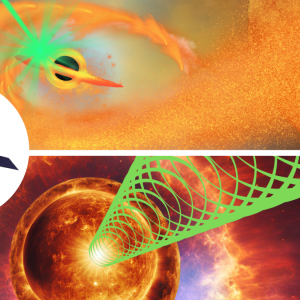
How Does RNAi Work?
The natural RNAi mechanism can be directed by either short interfering RNA (siRNA) or microRNA (miRNA).1 There are four key steps in the RNAi pathway.
- The double-stranded RNA (dsRNA) precursors of siRNA and miRNA bind to an endoribonuclease protein called Dicer, which cuts them into short sections of around 20 nucleotides.3
- These small dsRNA fragments then bind to an Argonaute protein. Argonaute selects and keeps one strand of the dsRNA as its guide strand, forming the RNA-induced silencing complex (RISC).5
- The guide strand then locates and binds to the complementary target messenger RNA (mRNA) via Watson-Crick base pairing.1
- Once the guide has paired with its target, the action will vary based on the type of guide. In the case of miRNA, RISC blocks translation of the mRNA. If guided by siRNA, RISC cleaves the target transcript. Both of these actions cause the mRNA to be subsequently degraded.6
- By cleaving the target mRNA or preventing its translation into a mature protein, RNAi effectively and specifically silences gene expression.7
When miRNA acts as the guide for RNAi, only a short part of the molecule, known as the seed region, pairs with the target, rather than the full ~20 nucleotide sequence.1 This means miRNA guides can target any mRNA with homology to its seed region, even if the rest of the sequence is not a match. This promiscuous binding activity means that miRNA can act on many different mRNAs, potentially silencing hundreds of genes simultaneously.
In contrast, when RNAi is guided by siRNA, the entire sequence pairs with the target strand with high complementarity. This often results in a 100 percent match between guide and target, with very low off-target activity. Additionally, siRNAs induce gene silencing by guiding histone and DNA methylation, which inactivates chromatin and represses transcription.1
RNAi Knockdown
Scientists have harnessed RNAi in the laboratory to selectively silence target gene expression, a technique known as gene knockdown.8 By delivering dsRNA that are complementary to a target gene’s mRNA, researchers redirect the RNAi pathway from its canonical functions to cleave the target and prevent its translation. Unlike gene knockout, which is complete and permanent, RNAi-based gene knockdown is partial and temporary.
[See Also: https://www.the-scientist.com/what-s-the-difference-between-gene-knockdown-and-gene-knockout-71988]
Using RNAi, researchers have successfully performed gene knockdown in a variety of organisms and cells, including mammalian cell lines, primary cells, and stem cells.9 Functional genomics researchers now commonly use RNAi to knock down genes and determine their function, including their roles in disease.
RNAi technology and its components have earned two Nobel Prizes in Physiology or Medicine. The first was awarded in 2006 to Andrew Z. Fire and Craig Mello for their 1998 Nature publication, in which they used dsRNA to manipulate gene expression in the model organism Caenorhabditis elegans.10 The second was awarded in 2024 to Victor Ambros and Gary Ruvkin for their discovery of miRNA and their role in PTGS.
[See also: https://www.the-scientist.com/nobel-prize-for-microrna-72227 ]
RNAi Applications
Researchers use RNAi-based gene knockdown in a variety of applications. In agriculture, scientists employ RNAi as a method to control plant pathogens, such as viruses and fungi, and ensure more sustainable crop production.11 They are similarly developing species-specific, environmentally-friendly pesticides with RNAi technology, for example by targeting essential genes in pest insects to cause mortality.12
Scientists also use RNAi to generate disease models and characterize gene functions across many different medical research areas, including infectious disease, cancer, and neurodegenerative disorders.8 High-throughput genome-wide RNAi screens have allowed researchers to identify many novel genes involved in disease pathogenesis.9
Because many genetic disorders are caused by the overexpression of particular genes or the buildup of toxic mRNA transcripts within cells, medical researchers can also harness RNAi to develop novel therapies for these diseases. For example, RNAi can potentially be used to treat Huntington’s disease, which is caused by a trinucleotide repeat expansion on one allele of the huntingtin gene.13 By enabling the specific targeting of only the mutated mRNA transcripts, RNAi-based therapies deplete the mutant transcripts while leaving the non-mutant transcripts intact, which are crucial for normal brain function.13
In 2018, the FDA approved the first RNAi-based therapy, a drug known as Patisiran. Designed to treat hereditary transthyretin amyloidosis, Patisiran uses siRNAs to direct the RNAi pathway to target transthyretin (TTR) gene transcripts, inhibiting mutant protein production.14
[See Also: https://www.the-scientist.com/the-promise-of-rnai-therapeutics-for-cardiovascular-disease-treatment-72267 ]
References
1. Kim DH, Rossi JJ. RNAi mechanisms and applications. Biotechniques. 2008;44(5):613-616.
2. El-Sappah AH, et al. Comprehensive mechanism of gene silencing and its role in plant growth and development. Front Plant Sci. 2021;12.
3. Downward J. RNA interference. BMJ. 2004;328(7450):1245.
4. Alberts B, et al. Molecular Biology of the Cell. 5th ed. (Anderson M, Granum S, eds.). Garland Science; 2008.
5. Das PR, Sherif SM. Application of exogenous dsRNAs-induced RNAi in agriculture: challenges and triumphs. Front Plant Sci. 2020;11.
6. Svoboda P. Key mechanistic principles and considerations concerning RNA interference. Front Plant Sci. 2020;11.
7. Han H. RNA interference to knock down gene expression. In: DiStefano JK, ed. Disease Gene Identification: Methods and Protocols. Springer New York; 2018:293-302.
8. Mocellin S, Provenzano M. RNA interference: learning gene knock-down from cell physiology. J Transl Med. 2004;2(1):39.
9. Leung RKM, Whittaker PA. RNA interference: from gene silencing to gene-specific therapeutics. Pharmacol Ther. 2005;107(2):222-239.
10. Fire A, et al. Potent and specific genetic interference by double-stranded RNA in Caenorhabditis elegans. Nature. 1998;391(6669):806-811.
11. Hernández-Soto A, Chacón-Cerdas R. RNAi crop protection advances. Int J Mol Sci. 2021;22(22).
12. Christiaens O, et al. Double-stranded RNA technology to control insect pests: current status and challenges. Front Plant Sci. 2020;11.
13. Lo DC, Hughes RE, eds. Neurobiology of Huntington’s Disease. 1st ed. CRC Press; 2010.
14. David A, et al. Patisiran, an RNAi therapeutic, for hereditary transthyretin amyloidosis. N Engl J Med. 2018;379(1):11-21.





